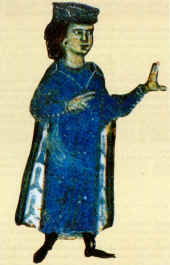
The Cantigas de Santa Maria are 420 poems with musical notation, written in the medieval Galician-Portuguese language during the reign of Alfonso X of Castile El Sabio (1221–1284). Traditionally, they are all attributed to Alfonso, though scholars have since established that the musicians and poets of his court were responsible for most of them, with Alfonso being credited with a few as well.
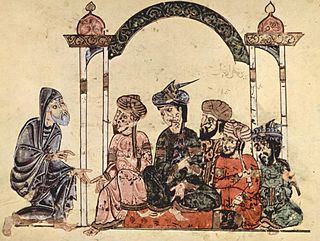
A kharja or kharjah, is the final refrain of a muwashshah, a lyric genre of Al-Andalus written in Arabic or Andalusi Romance (Mozarabic).

Galician-Portuguese, also known as Old Galician, Old Portuguese, Medieval Portuguese or as Medieval Galician when referring to the history of each modern language, was a West Iberian Romance language spoken in the Middle Ages, in the northwest area of the Iberian Peninsula. Alternatively, it can be considered a historical period of the Galician and Portuguese languages.
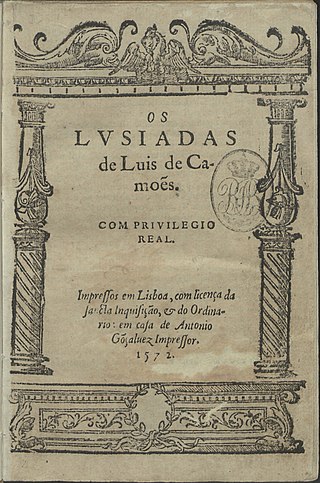
Portuguese literature is literature written in the Portuguese language. In its strictest sense it is literature written particularly by citizens of Portugal; more generally it may also refer to Lusophone literature written by authors from Brazil, Angola, Mozambique, and other Portuguese-speaking countries and territories. This article focuses on Portuguese literature sensu stricto, that is, literature from the country of Portugal.

Martin Codax or Codaz, Martín Codax or Martim Codax was a Galician medieval joglar, possibly from Vigo, Galicia in present-day Spain. He may have been active during the middle of the thirteenth century, judging from scriptological analysis. He is one of only two out of a total of 88 authors of cantigas d'amigo who used only the archaic strophic form aaB. He employed an archaic rhyme-system whereby i~o / a~o were used in alternating strophes. In addition Martin Codax consistently utilised a strict parallelistic technique known as leixa-pren. There is no documentary biographical information concerning the poet, dating the work at present remains based on theoretical analysis of the text.

Mendinho, also Meendinho, Mendiño and Meendiño, was a medieval Iberian poet.
Johan de Cangas was a jograr or non-noble troubadour, probably active during the thirteenth century. He seems to have been from—or associated with – Cangas do Morrazo, a small town of Pontevedra, Galicia (Spain). Only three of his songs survive. All three are cantigas de amigo and in each of them the girl mentions a religious site (ermida) at San Momede do Mar. These references to the sea may be symbolic as they are real, but they have earned this poet the designation of "singer of the sea". In the first text, a girl asks her mother for permission to go see her boyfriend at San Momede do Mar; in the second she informs her mother that the boyfriend did not come and she has surely lost him; in the third she asks her boyfriend to meet her there, and not to break his word to her again.

Cantiga de amigo or cantiga d'amigo, literally "friend song", is a genre of medieval lyric poetry, more specifically the Galician-Portuguese lyric, apparently rooted in a female-voiced song tradition native to the northwest quadrant of the Iberian Peninsula.

Na Castelloza was a noblewoman and trobairitz from Auvergne.
João Zorro was a late 13th century Galician or Portuguese minstrel at the court of Afonso III of Portugal, or as it is most likely at the court of Denis of Portugal. He is noted for his 10 cantigas de amigo about ancient sailors, written on the eve of the great voyages of discovery. Like most similar cantigas de amigo of his time, the musical notation wasn't recorded.
A cantiga is a medieval monophonic song, characteristic of the Galician-Portuguese lyric. Over 400 extant cantigas come from the Cantigas de Santa Maria, narrative songs about miracles or hymns in praise of the Holy Virgin. There are near 1700 secular cantigas but music has only survived for a very few: six cantigas de amigo by Martín Codax and seven cantigas de amor by Denis of Portugal.
A tenso is a style of troubadour song. It takes the form of a debate in which each voice defends a position; common topics relate to love or ethics. Usually, the tenso is written by two different poets, but several examples exist in which one of the parties is imaginary, including God, the poet's horse or his cloak. Closely related, and sometimes overlapping, genres include:
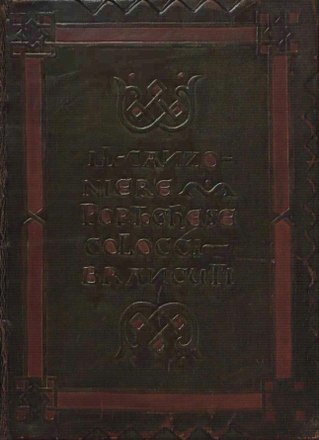
The Cancioneiro da Biblioteca Nacional, commonly called Colocci-Brancuti, is a compilation of Galician-Portuguese lyrics by both troubadours and jograes. These cantigas (songs) are classified, following indications in the poems themselves and in the manuscript tradition, into three main genres: cantigas de amigo, cantigas de amor and cantigas de escárnio e mal-dizer.
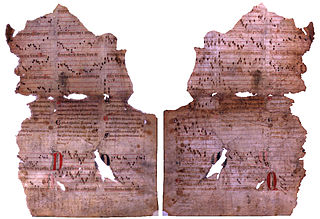
The Pergaminho Sharrer is a mediaeval parchment fragment containing seven songs by King Denis of Portugal, with lyrics in the Galician-Portuguese language and musical notation.
Paio Soares de Taveirós or Paay Soarez de Taveiroos seems to have been a minor Galician nobleman and troubadour active during the second and third decades of the 13th century. He was a brother of the troubadour Pêro Velho de Taveirós. Of his works, six cantigas de amor, three cantigas de amigo, and two tensos survive.
Airas Nunes was a Galician cleric and troubador of the 13th century. He served under a bishop and much later, between 1284 and 1289, was a poet in the court of Sancho IV of Castille.
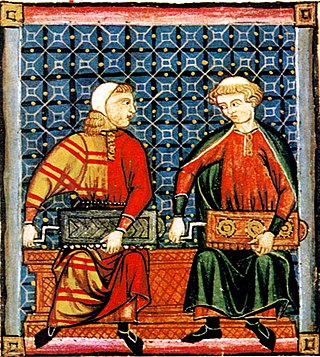
In the Middle Ages, the Galician-Portuguese lyric, also known as trovadorismo in Portugal and trobadorismo in Galicia, was a lyric poetic school or movement. All told, there are around 1680 texts in the so-called secular lyric or lírica profana. At the time Galician-Portuguese was the language used in nearly all of Iberia for lyric poetry. From this language derives both modern Galician and Portuguese. The school, which was influenced to some extent by the Occitan troubadours, is first documented at the end of the twelfth century and lasted until the middle of the fourteenth, with its zenith coming in the middle of the thirteenth century, centered on the person of Alfonso X, The Wise King. It is the earliest known poetic movement in Galicia or Portugal and represents not only the beginnings of but one of the high points of poetic history in both countries and in Medieval Europe. Modern Galicia has seen a revival movement called neotrobadorismo.
Cantiga da Ribeirinha is one of the first known pieces of literature in Galician-Portuguese. The poem's date of composition is debated, with some experts placing it in 1189 or 1198, and others claiming it could not have been written before 1200. It was composed by Paio Soares de Taveirós and received its name because it was dedicated to Maria Pais Ribeira, the mistress of Sancho I of Portugal, known as "Ribeirinha."
Bernal(do) de Bonaval(le), also known as Bernardo (de) Bonaval, was a 13th-century troubadour in the Kingdom of Galicia who wrote in the Galician-Portuguese language.

Cantigas de escárnio e maldizer (Portuguese), cantiga de escarnio e maldicir (Galician) or cantigas d'escarnho e de maldizer (Galician-Portuguese), literally "derision and curse songs", are a type of literary composition of insult, mockery and scorn – always with comic intent – from the Middle Ages, typical of the medieval Galician-Portuguese lyric.
